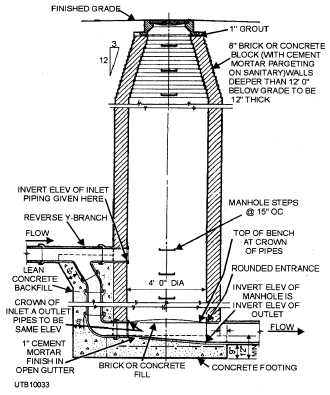Hello,
We were detailing drainage manholes yesterday, and I was wondering about the relevance of under drains. I assume I'm calling them by their correct name. I've seen them mostly as six inch pipes, entering the manholes near the top of the structures. What purpose do they serve?
Regards,
Mark
Most of the ones I have seen like that were roof drains, or smaller surface drainage lines installed by landscapers.
From what I've seen, underdrains are porous pipes that run along the side of roads, and are designed to keep the water table a few feet below the road level in that area.
That makes perfect sense to me. The particular structure I'm thinking of is located in a sidewalk, which runs along a road.
The drop manhole looks like a sanitary manhole. I'm referring to drainage manholes. I can't recall seeing under drains in sanitary manholes.
Does it make sense to include under drains in a drainage manhole detail? I guess that would depend on their purpose.
> From what I've seen, underdrains are porous pipes that run along the side of roads, and are designed to keep the water table a few feet below the road level in that area.
Ditto. The ones I see are exactly this and have seen them install these usually running parallel with the CL of the road at some offset and usually draining in a storm drain structure or ditch if there is no storm drain.
> Hello,
>
> We were detailing drainage manholes yesterday, and I was wondering about the relevance of under drains. I assume I'm calling them by their correct name. I've seen them mostly as six inch pipes, entering the manholes near the top of the structures. What purpose do they serve?
>
> Regards,
>
> Mark
Ohio Department of Transportation (ODOT) calls them "Pipe Underdrains" and they run under 18 inches to 30 inches deep just outside of the edge of pavement. They are intended to drain the granular base material under the pavement. The following link DM-1.2 PIPE UNDERDRAINS is to an ODOT standard construction drawing in pdf format.
This is a cool thread. I have never seen any in this area. but if I ever do, now I'll know what they are.
Are you talking about a catch basin instead of a manhole. A catch basin is usually located in the sidewalk area and has a curb opening to allow street storm water runoff to be collected. The catch basin will have a lateral pipe that will connect to the larger main storm drain in the street. Access into the catch basin is via a standard manhole cover. The catch basin comes in standard widths and are generally rectangular in shape.
The 6" pipe you would typically see outletting into the wall of the catch basin is either a roof drain, a yard drain or a parking lot drain.
> The drop manhole looks like a sanitary manhole. I'm referring to drainage manholes. I can't recall seeing under drains in sanitary manholes.
My bad, you did say that. Carry on
They are under drains that are put in to collect any water that has made it into the base stone of the roadway. Generally they are 4" dia on local roads and 6" dia on interstates. Here in Tennessee, TDOT requires them on most all roads.
Are you thinking of French Drains
There are many sod airstrips in this area and it is common to install fields of perforated pvc pipe across them for drainage.
Hey mate,
The way you've described it sounds like a sub-soil drain, also referred to as an agricultural line. It's used to control ground water levels to help keep the surrounding area dry. We commonly install them behind the kerb or in the table drain on the high side of the road to intercept ground water before it reaches and saturates the road pavement. We've also run them through the centre of swale drains to dry them out so they can be routinely maintained.
You might also see them laid on the last few meters on the downstream end of a storm water drainage line to drain any ground water which has followed the trench into the pit.
In my facility they are used in the rail yards to provide track and ballast drainage, usually 6"-8" HDPE corrugated and slotted, encased in clean stone and wrapped with silt fabric to keep them clean.
If you're in a residential or commercial area, these may be roof drains since you said they're coming in at the top of the manhole.
Typically an underdrain is used around retaining walls and underground basins to collect water to avoid any erosion and the like and would probably come in at the bottom of the manhole, but it really depends on the depth of said basin.
If you're in a rural area... it could be anything.
They were corrugated plastic pipes. I couldn't see if they were perforated.
Interesting!
Thanks for responding! I'm talking about a curb inlet with a manhole and lateral pipes. In Florida, we also call a catch basin a flat grate inlet (FGI).




